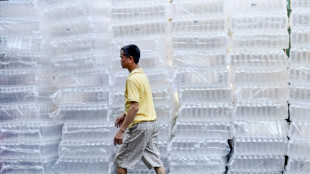
-
 Sampaoli beaten on Rennes debut as angry fans disrupt Nantes loss
Sampaoli beaten on Rennes debut as angry fans disrupt Nantes loss
-
Chiefs edge Panthers, Lions rip Colts as Dallas stuns Washington

-
 Uruguayans vote in tight race for president
Uruguayans vote in tight race for president
-
Thailand's Jeeno wins LPGA Tour Championship

-
 'Crucial week': make-or-break plastic pollution treaty talks begin
'Crucial week': make-or-break plastic pollution treaty talks begin
-
Israel, Hezbollah in heavy exchanges of fire despite EU ceasefire call

-
 Amorim predicts Man Utd pain as he faces up to huge task
Amorim predicts Man Utd pain as he faces up to huge task
-
Basel backs splashing the cash to host Eurovision

-
 Petrol industry embraces plastics while navigating energy shift
Petrol industry embraces plastics while navigating energy shift
-
Italy Davis Cup winner Sinner 'heartbroken' over doping accusations

-
 Romania PM fends off far-right challenge in presidential first round
Romania PM fends off far-right challenge in presidential first round
-
Japan coach Jones abused by 'some clown' on Twickenham return

-
 Springbok Du Toit named World Player of the Year for second time
Springbok Du Toit named World Player of the Year for second time
-
Iran says will hold nuclear talks with France, Germany, UK on Friday

-
 Mbappe on target as Real Madrid cruise to Leganes win
Mbappe on target as Real Madrid cruise to Leganes win
-
Sampaoli beaten on Rennes debut as fans disrupt Nantes loss

-
 Israel records 250 launches from Lebanon as Hezbollah targets Tel Aviv, south
Israel records 250 launches from Lebanon as Hezbollah targets Tel Aviv, south
-
Australia coach Schmidt still positive about Lions after Scotland loss

-
 Man Utd 'confused' and 'afraid' as Ipswich hold Amorim to debut draw
Man Utd 'confused' and 'afraid' as Ipswich hold Amorim to debut draw
-
Sinner completes year to remember as Italy retain Davis Cup

-
 Climate finance's 'new era' shows new political realities
Climate finance's 'new era' shows new political realities
-
Lukaku keeps Napoli top of Serie A with Roma winner

-
 Man Utd held by Ipswich in Amorim's first match in charge
Man Utd held by Ipswich in Amorim's first match in charge
-
'Gladiator II', 'Wicked' battle for N. American box office honors

-
 England thrash Japan 59-14 to snap five-match losing streak
England thrash Japan 59-14 to snap five-match losing streak
-
S.Africa's Breyten Breytenbach, writer and anti-apartheid activist

-
 Concern as climate talks stalls on fossil fuels pledge
Concern as climate talks stalls on fossil fuels pledge
-
Breyten Breytenbach, writer who challenged apartheid, dies at 85

-
 Tuipulotu try helps Scotland end Australia's bid for Grand Slam
Tuipulotu try helps Scotland end Australia's bid for Grand Slam
-
Truce called after 82 killed in Pakistan sectarian clashes

-
 Salah wants Liverpool to pile on misery for Man City after sinking Saints
Salah wants Liverpool to pile on misery for Man City after sinking Saints
-
Berrettini takes Italy to brink of Davis Cup defence

-
 Lille condemn Sampaoli to defeat on Rennes debut
Lille condemn Sampaoli to defeat on Rennes debut
-
Basel backs splashing the bucks to host Eurovision

-
 Leicester sack manager Steve Cooper
Leicester sack manager Steve Cooper
-
IPL auction records tumble as Pant, Iyer break $3 mn mark

-
 Salah sends Liverpool eight points clear after Southampton scare
Salah sends Liverpool eight points clear after Southampton scare
-
Key Trump pick calls for end to escalation in Ukraine

-
 Tuipulotu try helps Scotland end Australia's bid for a Grand Slam
Tuipulotu try helps Scotland end Australia's bid for a Grand Slam
-
Davis Cup organisers hit back at critics of Nadal retirement ceremony

-
 Noel in a 'league of his own' as he wins Gurgl slalom
Noel in a 'league of his own' as he wins Gurgl slalom
-
A dip or deeper decline? Guardiola seeks response to Man City slump

-
 Germany goes nuts for viral pistachio chocolate
Germany goes nuts for viral pistachio chocolate
-
EU urges immediate halt to Israel-Hezbollah war

-
 Far right targets breakthrough in Romania presidential vote
Far right targets breakthrough in Romania presidential vote
-
Basel votes to stump up bucks to host Eurovision

-
 Ukraine shows fragments of new Russian missile after 'Oreshnik' strike
Ukraine shows fragments of new Russian missile after 'Oreshnik' strike
-
IPL auction records tumble as Pant and Iyer snapped up

-
 Six face trial in Paris for blackmailing Paul Pogba
Six face trial in Paris for blackmailing Paul Pogba
-
Olympic champion An wins China crown in style


Why South America is burning
A record wave of wildfires, fueled by severe drought linked to climate change and deforestation, is causing havoc across South America.
The blazes have killed at least 30 people, left cities shrouded in toxic smoke and caused millions of dollars in economic losses.
This fire season is "completely different" from the one that ravaged forests in Brazil, Peru and Bolivia in 2019, according to Brazilian environmentalist Erika Berenguer, a researcher at Oxford University.
At the time, rain helped douse the fires, which in Brazil were chiefly started by farmers taking advantage of lax legislation under then far-right president Jair Bolsonaro to clear land for crops and ranching.
This year, the continent is in the throes of a severe drought. The Amazon basin, usually one of the wettest places on Earth, is experiencing the worst fires in nearly two decades, according to the EU's Copernicus observatory.
Berenguer blamed climate change for making the Amazon "highly flammable."
- How bad are the fires? -
Between January 1 and September 26, more than 400,000 fires were recorded across South America, according to Brazil's National Institute for Space Research (INPE).
"In nine months we have already surpassed the number of outbreaks recorded in all of 2023," Berenguer noted.
In Brazil, the flames have consumed 40.2 million hectares (99 million acres) of vegetation this year, far above the average of 31 million hectares in each of the last 10 years, according to Copernicus.
A dozen firefighters have died on duty, according to local media.
In Ecuador, the mayor of the capital Quito declared this week the Andean city was "under attack" from 27 fires which forced the evacuation of over 100 families before being brought under control.
Ecuador had declared an emergency in several provinces, as has Peru, where 21 people have been killed by fires since July. Most were small-scale farmers.
Several fires are also blazing in Argentina and in Colombia, at opposite ends of the continent.
- What's causing the fires? -
Experts and national authorities point to a combination of combustible factors, chiefly droughts aggravated by climate change and slash-and-burn agriculture.
"It's a clear example of climate change. If anyone thought it didn't exist, well look, here it is," said Ecuadoran Environment Minister Ines Manzano.
In Peru and Bolivia, some of the fires are believed to have been started by farmers burning land to make it more fertile for planting, a traditional practice in the Andean countries that is tolerated by the authorities.
In the Brazilian Amazon, fires lit by both subsistence farmers and the agribusiness industry to clear forest for cattle or crops were fanned by the worst drought in the country's recent history.
President Luiz Inacio Lula da Silva, who has pledged to put a stop to illegal Amazon deforestation by 2030, considers most of the fires to be "criminal" in origin.
In some places, the fires are started by arsonists.
One person has been arrested in Quito and dozens in Argentina and Brazil on suspicion of maliciously starting fires.
- How are people affected? -
The fires have dramatically reduced air quality in several cities.
Sao Paulo, the largest city in Latin America, was ranked the most polluted city in the world in early September, according to Swiss company IQAir.
A large part of Brazil remains shrouded in acrid smoke that wafted as far south as Montevideo and Buenos Aires earlier this month, causing a phenomenon known as "black rain."
Inhabitants of many of Brazilian cities are experiencing respiratory problems and other symptoms such as stinging eyes.
In Bolivia, health authorities have recommended people wear face masks because of the poor air quality.
The region's economies are also feeling the burn. Losses in the Brazilian agricultural sector amounted to $2.7 billion between June and August, principally sugarcane harvests.
In Ecuador, nearly 45,000 farm animals have died after more than two months without rain.
- What are governments doing? -
Thousands of firefighters and soldiers have been deployed across the continent to tackle the blazes.
"Everyone wants to hire thousands of firefighters, buy aircraft, etc, etc. That's fine but it's too little, too late," Berenguer said.
"We need to prevent fires, because once they become big they are very difficult to fight," she said, advocating for tougher measures against deforestation and planet-warming greenhouse gas emissions.
burs-jss/cb/mlr/acb
J.Fankhauser--BTB


